-

新人教版高中英语选修2Unit 4 Learning about Language教学设计
This section guides students to pay attention to the typical context of vocabulary use, helps students accumulate vocabulary around the key vocabulary of this unit, and uses the learned words and word chunks in different contexts to deeply understand their meaning and usage, so as to achieve the purpose of review and consolidation.The teaching design activities aim to guide students to pay attention to the typical context in which the target vocabulary is used, as well as the common vocabulary used in collocation, so that students can complete the sentence with correct words. In terms of vocabulary learning strategies, this unit focuses on cultivating students' ability to pay attention to collocation of words and to use word blocks to express meaning.For vocabulary learning, it is not enough just to know the meaning of a single word, but the most important thing is to master the common collocations of words, namely word blocks.Teachers should timely guide students to summarize common vocabulary collocation, such as verb and noun collocation, verb and preposition collocation, preposition and noun collocation, and so on.1. Guide students to understand and consolidate the meaning and usage of the vocabulary in the context, 2. Guide the students to use the unit topic vocabulary in a richer context3. Let the students sort out and accumulate the accumulated vocabulary, establishes the semantic connection between the vocabulary,4. Enable students to understand and master the vocabulary more effectivelyGuiding the Ss to use unit topic words and the sentence patterns in a richer context.

新人教版高中英语选修2Unit 4 Reading for writing教学设计
假定你是英国的Jack,打算来中国旅行,请你给你的中国笔友李华写一封信,要点如下:1.你的旅行计划:北京→泰山→杭州;2.征求建议并询问他是否愿意充当你的导游。注意:1.词数80左右(开头和结尾已给出,不计入总词数);2.可以适当增加细节,以使行文连贯。参考词汇:故宫 the Forbidden City;泰山 Mount TaiDear Li Hua,I'm glad to tell you that 'm going to visit China.First,I am planning to visit Beijing,the capitalof China,where I am looking forward to enjoying the Great Wall,the Forbidden City and somebeautiful parks.Then I intend to go to visit Mount Tai in Shandong Province.I've heard that it is one ofthe most famous mountains in China and I can't wait to enjoy the amazing sunrise there.After that,I amalso going to Hangzhou.It is said that it is a beautiful modern city with breathtaking natural sights,among which the West Lake is a well- known tourist attraction.What do you think of my travel plan? Will you act as my guide? Hope to hear from you soon.

新人教版高中英语选修2Unit 4 Using langauge-Listening教学设计
The theme of the listening section is " talking about scenery and culture along a journey."The part is designed to further lead the students to understand Canadian natural geography and social environment, and integrated into the cultural contrast by mentioning the long train journey from Beijing to Moscow routes. On this basis, the part activates students related travel experience, lets the student serial dialogue, guides the student to explore further the pleasure and meaning of the long journey, and Chinese and foreign cultural comparison.The part also provides a framework for the continuation of the dialogue, which is designed to provide a framework for students to successfully complete their oral expressions, and to incorporate an important trading strategy to end the dialogue naturally.1. Help students to understand and master some common English idioms in the context, and experience the expression effect of English idioms.2. Guide the students to understand the identity of different people in the listening context, and finish the dialogue according to their own experience.3. Instruct the students to use appropriate language to express surprise and curiosity about space and place in the dialogue, and master the oral strategy of ending the dialogue naturally.1. Instruct students to grasp the key information and important details of the dialogue.2. Instruct students to conduct a similar talk on the relevant topic.

新人教版高中英语选修2Unit 5 Learning about Language教学设计
The purpose of this section of vocabulary exercises is to consolidate the key words in the first part of the reading text, let the students write the words according to the English definition, and focus on the detection of the meaning and spelling of the new words. The teaching design includes use English definition to explain words, which is conducive to improving students' interest in vocabulary learning, cultivating their sense of English language and thinking in English, and making students willing to use this method to better grasp the meaning of words, expand their vocabulary, and improve their ability of vocabulary application. Besides, the design offers more context including sentences and short passage for students to practice words flexibly.1. Guide students to understand and consolidate the meaning and usage of the vocabulary in the context, 2. Guide the students to use the unit topic vocabulary in a richer context3. Let the students sort out and accumulate the accumulated vocabulary, establishes the semantic connection between the vocabulary,4. Enable students to understand and master the vocabulary more effectivelyGuiding the Ss to use unit topic words and the sentence patterns in a richer context.Step1: Read the passage about chemical burns and fill in the blanks with the correct forms of the words in the box.

新人教版高中英语选修2Unit 5 Reading and thinking教学设计
The theme of this activity is to learn the first aid knowledge of burns. Burns is common in life, but there are some misunderstandings in manual treatment. This activity provides students with correct first aid methods, so as not to take them for granted in an emergency. This section guides students to analyze the causes of scald and help students avoid such things. From the perspective of text structure and collaborative features, the text is expository. Expository, with explanation as the main way of expression, transmits knowledge and information to readers by analyzing concepts and elaborating examples. This text arranges the information in logical order, clearly presents three parts of the content through the subtitle, accurately describes the causes, types, characteristics and first aid measures of burns, and some paragraphs use topic sentences to summarize the main idea, and the level is very clear.1. Guide students to understand the causes, types, characteristics and first aid methods of burns, through reading2. Enhance students’ ability to deal withburnss and their awareness of burns prevention3. Enable students to improve the ability to judge the types of texts accurately and to master the characteristics and writing techniques of expository texts.Guide students to understand the causes, types, characteristics and first aid methods of burns, through readingStep1: Lead in by discussing the related topic:1. What first-aid techniques do you know of ?CPR; mouth to mouth artificial respiration; the Heimlich Manoeuvre

新人教版高中英语选修2Unit 5 Using langauge-Listening教学设计
The theme of this section is to learn how to make emergency calls. Students should learn how to make emergency calls not only in China, but also in foreign countries in English, so that they can be prepared for future situations outside the home.The emergency telephone number is a vital hotline, which should be the most clear, rapid and effective communication with the acute operator.This section helps students to understand the emergency calls in some countries and the precautions for making emergency calls. Through the study of this section, students can accumulate common expressions and sentence patterns in this context. 1.Help students accumulate emergency telephone numbers in different countries and learn more about first aid2.Guide the students to understand the contents and instructions of the telephone, grasp the characteristics of the emergency telephone and the requirements of the emergency telephone.3.Guide students to understand the first aid instructions of the operators.4.Enable Ss to make simulated emergency calls with their partners in the language they have learned1. Instruct students to grasp the key information and important details of the dialogue.2. Instruct students to conduct a similar talk on the relevant topic.Step1:Look and discuss:Match the pictures below to the medical emergencies, and then discuss the questions in groups.
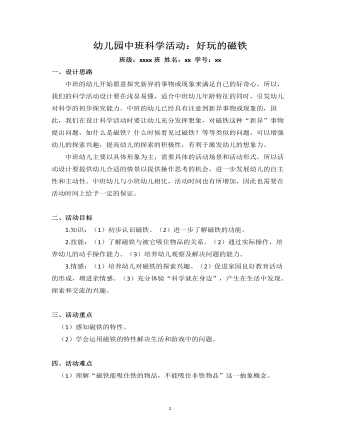
好玩的磁铁教案教学设计
中班的幼儿开始愿意探究新异的事物或现象来满足自己的好奇心,所以,我们的科学活动设计要在浅显易懂,适合中班幼儿年龄特征的同时,引发幼儿对科学的初步探究能力。中班的幼儿已经具有注意到新异事物或现象的,因此,我们在设计科学活动时要让幼儿充分发挥想象,对磁铁这种“新异”事物提出问题,如什么是磁铁?什么时候看见过磁铁?等等类似的问题,可以增强幼儿的探索兴趣,提高幼儿的探索的积极性,有利于激发幼儿的想象力。 中班幼儿主要以具体形象为主,需要具体的活动场景和活动形式,所以活动设计要提供幼儿合适的情景以提供操作思考的机会,进一步发展幼儿的自主性和主动性。中班幼儿与小班幼儿相比,活动时间也有所增加,因此也需要在活动时间上给予一定的保证。
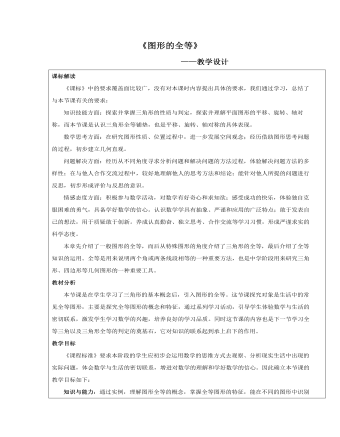
图形的全等教案教学设计
教法分析:在新课程的教学中教师要向学生提供从事数学活动的机会,倡导让学生亲身经历数学知识的形成与应用过程,鼓励学生自主探索与合作交流,让学生在实践中体验、学习。因此,本节课我采用了多媒体辅助教学与学生动手操作、观察、讨论的方式,一方面能够直观、生动地反映各种图形的特征,增加课堂的容量,吸引学生注意力,激发学生的学习兴趣;另一方面也有利于突出重点、突破难点,更好地提高课堂效率。学法分析:初二年级学习对新事物比较敏感,通过新课程教学的实施,学生已具有一定探索学习与合作交流的习惯。但是一下子要学生从直观的图形去概括出抽象图形全等的概念这是比较困难的。因此,我指导学生:一要善于观察发现;二要勇于探索、动手实验;三要把自己的所思所想大胆地进行交流,从而得出正确的结论,并掌握知识。
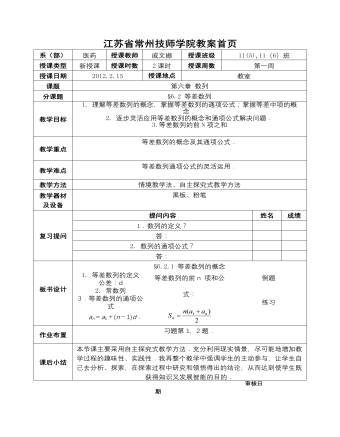
高教版中职数学基础模块下册:6.2《等差数列》教学设计
系(部)医药授课教师戚文撷授课班级11(5),11(6)班授课类型新授课授课时数2课时授课周数第一周授课日期2012.2.15授课地点 教室课题第六章数列分课题§6.2 等差数列教学目标1. 理解等差数列的概念,掌握等差数列的通项公式;掌握等差中项的概念. 2. 逐步灵活应用等差数列的概念和通项公式解决问题. 3.等差数列的前N项之和 . 4.培养学生分析、比较、归纳的逻辑思维能力. . 2. 3.教学重点等差数列的概念及其通项公式. 教学难点等差数列通项公式的灵活运用. 教学方法情境教学法、自主探究式教学方法教学器材及设备黑板、粉笔复习提问提问内容姓名成绩1.数列的定义? 答: 2. 数列的通项公式? 答: 板书设计 §6.2.1等差数列的概念 1. 1.等差数列的定义 公差:d 2.常数列 3.等差数列的通项公式 an=a1+(n-1)d. 等差数列的前n 项和公式: 例题 练习作业布置习题第1,2题.课后小结本节课主要采用自主探究式教学方法.充分利用现实情景,尽可能地增加教学过程的趣味性、实践性.我再整个教学中强调学生的主动参与,让学生自己去分析、探索,在探索过程中研究和领悟得出的结论,从而达到使学生既获得知识又发展智能的目的.
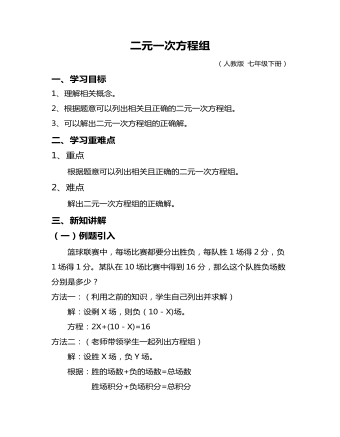
初中数学人教版二元一次方程组教学设计教案
(一)例题引入篮球联赛中,每场比赛都要分出胜负,每队胜1场得2分,负1场得1分。某队在10场比赛中得到16分,那么这个队胜负场数分别是多少?方法一:(利用之前的知识,学生自己列出并求解)解:设剩X场,则负(10-X)场。方程:2X+(10-X)=16方法二:(老师带领学生一起列出方程组)解:设胜X场,负Y场。根据:胜的场数+负的场数=总场数 胜场积分+负场积分=总积分得到:X+Y=10 2X+Y=16
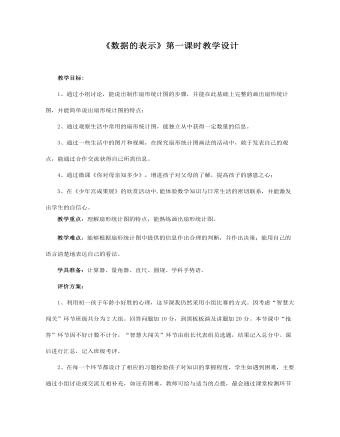
数据的收集与整理 3 数据的表示教案教学设计
创设情境,导入新课:你对母亲知多少师问1:我们5月份刚过了一个重要的节日,你知道是什么吗?----母亲节。师问2:那你知道妈妈的生日吗?(举手示意),每个妈妈都知道自己孩子的生日,请不知道的同学回家了解一下,多关心一下自己的父母。师问3:那你知道妈妈最爱吃的菜吗?你可以选择知道、不知道或者是没有爱吃的(拖动白板上相对应的表情符号)。请大家用不同的手势表示出来。我找3名同学统计各组的数据,写在黑板上(随机找3名学生数人数)。下面我来随机采访一下:你妈妈最喜欢吃的菜是什么?(教师随机采访,结合营养搭配和感恩教育)
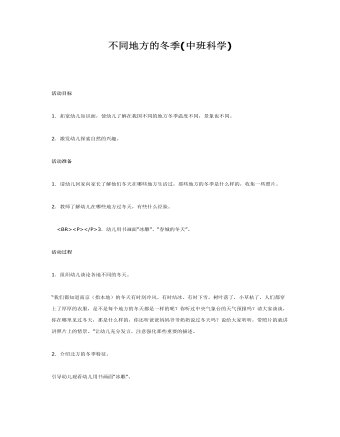
中班科学课件教案:不同地方的冬季
2.激发幼儿探索自然的兴趣。活动准备1.请幼儿回家向家长了解他们冬天在哪些地方生活过,那些地方的冬季是什么样的,收集一些照片。2.教师了解幼儿在哪些地方过冬天,有些什么经验。 <BR><P></P>3.幼儿用书画面“冰雕”、“春城的冬天”。活动过程1.组织幼儿谈论各地不同的冬天。“我们都知道南京(指本地)的冬天有时刮冷风、有时结冰、有时下雪,树叶落了,小草枯了,人们都穿上了厚厚的衣服,是不是每个地方的冬天都是一样的呢?你听过中央气象台的天气预报吗?请大家谈谈,你在哪里见过冬天,那是什么样的,你还听爸爸妈妈爷爷奶奶说过冬天吗?说给大家听听,带照片的就讲讲照片上的情景。”让幼儿充分发言,注意强化那些重要的描述。2.介绍北方的冬季特征。引导幼儿观看幼儿用书画面“冰雕”。“这里的冬天是怎样的?为什么别的地方没有冰雕”(因为这里冬季气温特别低,冰层很厚,几个月不化)3.介绍春城昆明的冬季特征。引导 <BR><P></P>幼儿观看幼儿用书画面“春城的冬天”,介绍昆明实际上一年到头都是春天。冬天也和春天一样,植物繁茂。郁郁葱葱,鲜花盛开,从不下雪,不结冰。人们穿着单薄。“这里有冬天吗?”4.小结。活动延伸观看世界各地冬天的录象。活动目标1.拓宽幼儿知识面,使幼儿了解在我国不同的地方冬季温度不同,景象也不同。2.激发幼儿探索自然的兴趣。活动准备1.请幼儿回家向家长了解他们冬天在哪些地方生活过,那些地方的冬季是什么样的,收集一些照片。2.教师了解幼儿在哪些地方过冬天,有些什么经验。3.幼儿用书画面“冰雕”、“春城的冬天”。
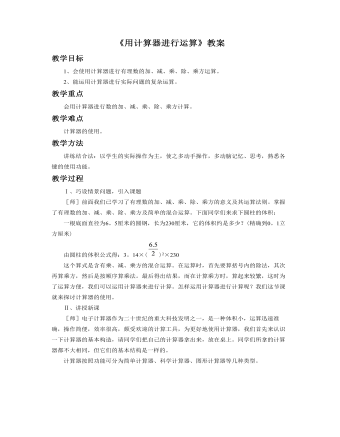
利用计算器进行有理数的计算教案教学设计
计算器的面板是由键盘和显示器组成的。显示器是用来显示输入的数据和计算结果的装置。显示器因计算器的种类不同而不同,有单行显示的,也有双行显示的。在键盘的每个键上,都标明了这个键的功能。我们看键盘上标有的键,是开机键,在开始使用计算器时先要按一下这个键,以接通电源,计算器的电源一般用5号电池或钮扣电池。再看键,是关机键,停止使用计算器时要按一下这个键,来切断计算器的电源,是清除键,按一下这个键,计算器就清除当前显示的数与符号。的功能是完成运算或执行命令。是运算键,按一下这个键,计算器就执行加法运算。
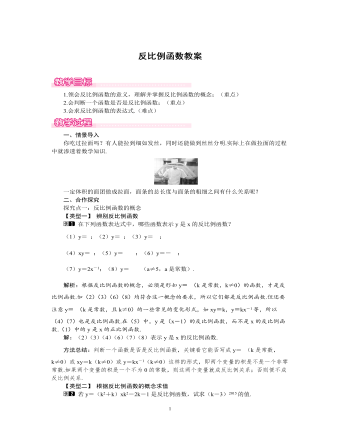
北师大初中数学九年级上册反比例函数1教案
解:(1)根据题意,可得y=100025x,化简得y=40x;(2)根据题设可知自变量x的取值范围为0<x<85.方法总结:反比例函数的自变量取值范围是全体非零实数,但在解决实际问题的过程中,自变量的取值范围要根据实际情况来确定.解题过程中应该注意对题意的正确理解.三、板书设计反比例函数概念:一般地,如果两个变量x,y之间 的对应关系可以表示成y=kx(k 为常数,k≠0)的形式,那么称y 是x的反比例函数,反比例函数 的自变量x不能为0确定表达式:待定系数法建立反比例函数的模型结合实例引导学生了解所讨论的函数的表达形式,形成反比例函数概念的具体形象,从感性认识到理性认识的转化过程,发展学生的思维.利用多媒体创设大量生活情境,让学生体验数学来源于生活实际,并为生活实际服务,让学生感受数学有用,从而培养学生学习数学的兴趣.
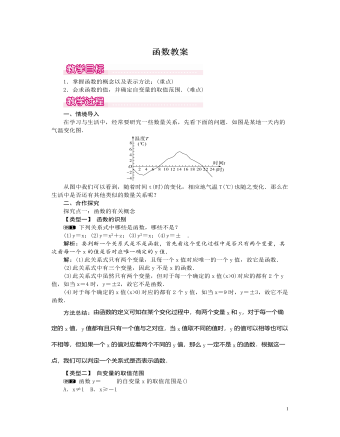
北师大初中数学八年级上册函数1教案
探究点三:函数的图象洗衣机在洗涤衣服时,每浆洗一遍都经历了注水、清洗、排水三个连续过程(工作前洗衣机内无水).在这三个过程中,洗衣机内的水量y(升)与浆洗一遍的时间x(分)之间函数关系的图象大致为()解析:∵洗衣机工作前洗衣机内无水,∴A,B两选项不正确,淘汰;又∵洗衣机最后排完水,∴D选项不正确,淘汰,所以选项C正确,故选C.方法总结:本题考查了对函数图象的理解能力,看函数图象要理解两个变量的变化情况.三、板书设计函数定义:自变量、因变量、常量函数的关系式三种表示方法函数值函数的图象在教学过程中,注意通过对以前学过的“变量之间的关系”的回顾与思考,力求提供生动有趣的问题情境,激发学生的学习兴趣,并通过层层深入的问题设计,引导学生进行观察、操作、交流、归纳等数学活动.在活动中归纳、概括出函数的概念,并通过师生交流、生生交流、辨析识别等加深学生对函数概念的理解.
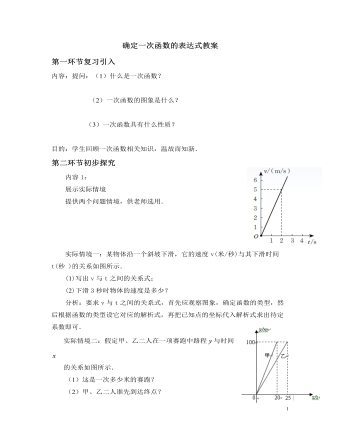
北师大初中数学八年级上册确定一次函数的表达式2教案
四个不同类型的问题由浅入深,学生能从不同角度掌握求一次函数的方法.对于问题4,教师可引导学生分析,并教学生要学会画图,利用图象分析问题,体会数形结合方法的重要性.学生若出现解题格式不规范的情况,教师应纠正并给予示范,训练学生规范答题的习惯.第五环节课时小结内容:总结本课知识与方法1.本节课主要学习了怎样确定一次函数的表达式,在确定一次函数的表达式时可以用待定系数法,即先设出解析式,再根据题目条件(根据图象、表格或具体问题)求出 , 的值,从而确定函数解析式。其步骤如下:(1)设函数表达式;(2)根据已知条件列出有关k,b的方程;(3)解方程,求k,b;4.把k,b代回表达式中,写出表达式.2.本节课用到的主要的数学思想方法:数形结合、方程的思想.目的:引导学生小结本课的知识及数学方法,使知识系统化.第六环节作业布置习题4.5:1,2,3,4目的:进一步巩固当天所学知识。教师也可根据学生情况适当增减,但难度不应过大.
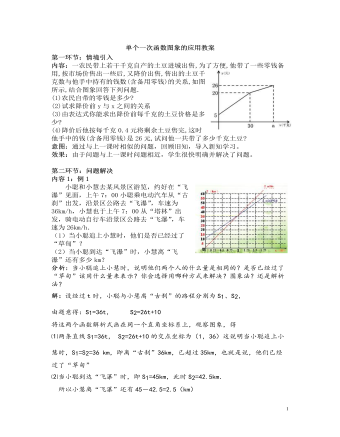
北师大初中数学八年级上册单个一次函数图象的应用2教案
(1)用简洁明快的语言概括大意,不能超过200字;(2)图表中能确定的数值,在故事叙述中不得少于3个,且要分别涉及时间、路和速度这三个量.意图:旨在检测学生的识图能力,可根据学生情况和上课情况适当调整。说明:练习注意了问题的梯度,由浅入深,一步步引导学生从不同的图象中获取信息,对同学的回答,教师给予点评,对回答问题暂时有困难的同学,教师应帮助他们树立信心。第四环节:课时小结内容:本节课我们学习了一次函数图象的应用,在运用一次函数解决实际问题时,可以直接从函数图象上获取信息解决问题,当然也可以设法得出各自对应的函数关系式,然后借助关系式完全通过计算解决问题。通过列出关系式解决问题时,一般首先判断关系式的特征,如两个变量之间是不是一次函数关系?当确定是一次函数关系时,可求出函数解析式,并运用一次函数的图象和性质进一步求得我们所需要的结果.
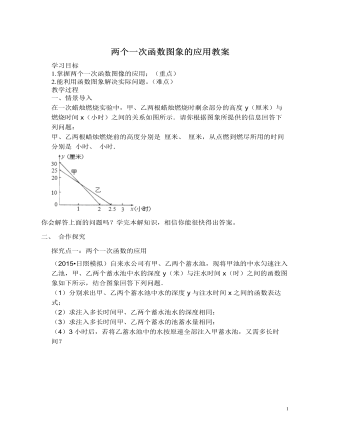
北师大初中数学八年级上册两个一次函数图象的应用2教案
学习目标1.掌握两个一次函数图像的应用;(重点)2.能利用函数图象解决实际问题。(难点)教学过程一、情景导入在一次蜡烛燃烧实验中,甲、乙两根蜡烛燃烧时剩余部分的高度y(厘米)与燃烧时间x(小时)之间的关系如图所示.请你根据图象所提供的信息回答下列问题:甲、乙两根蜡烛燃烧前的高度分别是 厘米、 厘米,从点燃到燃尽所用的时间分别是 小时、 小时.你会解答上面的问题吗?学完本解知识,相信你能很快得出答案。二、 合作探究探究点一:两个一次函数的应用(2015?日照模拟)自来水公司有甲、乙两个蓄水池,现将甲池的中水匀速注入乙池,甲、乙两个蓄水池中水的深度y(米)与注水时间x(时)之间的函数图象如下所示,结合图象回答下列问题.(1)分别求出甲、乙两个蓄水池中水的深度y与注水时间x之间的函数表达式;(2)求注入多长时间甲、乙两个蓄水池水的深度相同;(3)求注入多长时间甲、乙两个蓄水的池蓄水量相同;
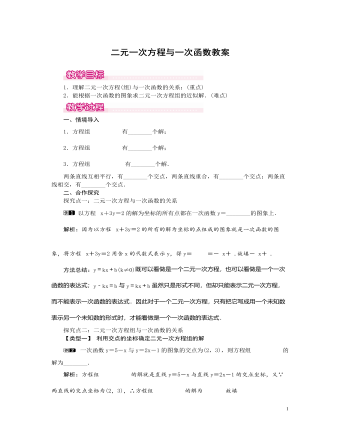
北师大初中数学八年级上册二元一次方程与一次函数1教案
由②得y=23x+23.在同一直角坐标系中分别作出一次函数y=3x-4和y=23x+23的图象.如右图,由图可知,它们的图象的交点坐标为(2,2).所以方程组3x-y=4,2x-3y=-2的解是x=2,y=2.方法总结:用画图象的方法可以直观地获得问题的结果,但不是很准确.三、板书设计1.二元一次方程组的解是对应的两条直线的交点坐标;2.用图象法解二元一次方程组的步骤:(1)变形:把两个方程化为一次函数的形式;(2)作图:在同一坐标系中作出两个函数的图象;(3)观察图象,找出交点的坐标;(4)写出方程组的解.通过引导学生自主学习探索,进一步揭示了二元一次方程和函数图象之间的对应关系,很自然的得到二元一次方程组的解与两条直线的交点之间的对应关系.进一步培养了学生数形结合的意识,充分提高学生数形结合的能力,使学生在自主探索中学会不同数学知识间可以互相转化的数学思想和方法.
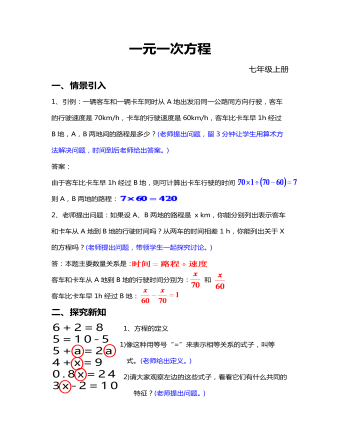
一元一次方程教案教学设计
1、方程的定义1)像这种用等号“=”来表示相等关系的式子,叫等式。(老师给出定义。)2)请大家观察左边的这些式子,看看它们有什么共同的特征?(老师提出问题。)3)列方程时,要先设字母表示未知数,然后根据问题中的相等关系,写出含有未知数的等式叫做方程。(学生思考后,老师给出新学内容方程的定义。)4)判断方程的两个关键要素: ①有未知数 ②是等式(老师提问,并给出。)